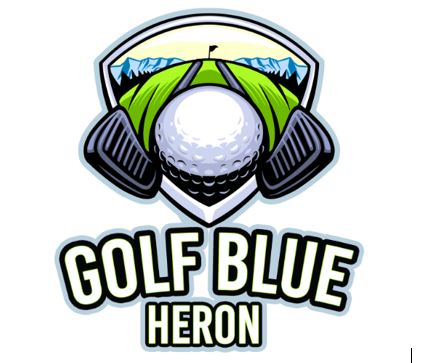

Titleist Pro V1X Vs. Titleist Tour Soft Golf Balls Comparison Overview
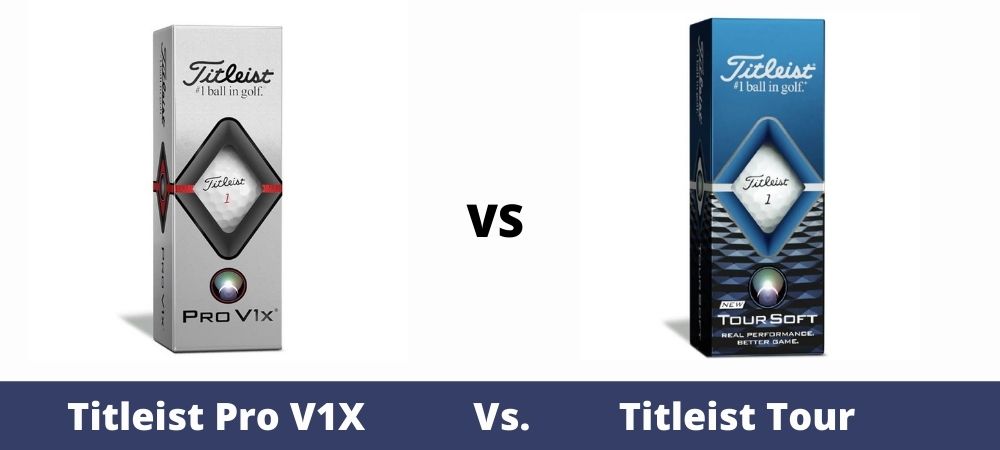
For some people (ourselves included) a real deal breaker when it comes to golf balls is cover material. We personally favor balls with urethane covers 9 times out of 10.
There are some composite materials that come close but in our humble opinion, there’s no mistaking the feel of pure urethane.
Urethane is super-thin, soft and responsive. But we are always open to having our minds changed. That’s why we went out and tested a tour-grade urethane ball next to a premium grade composite cover material.
Titleist Pro V1X Golf Balls Overview
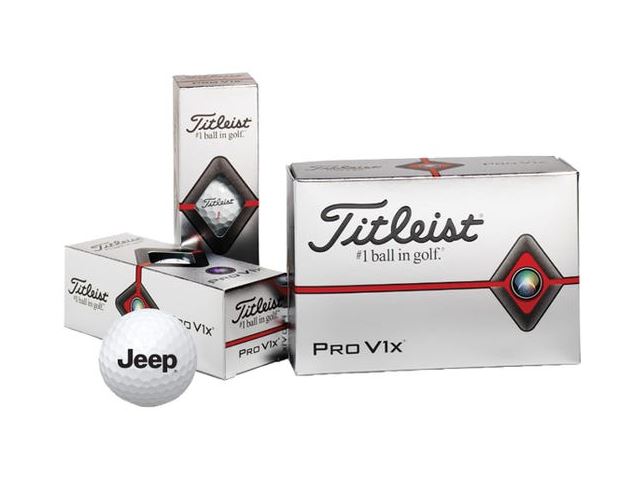
The Titleist Pro V1X sport a thin urethane cover and have become darlings on the PGA Tour for good reason.
Mainly because they perform from tee to pin. It should be noted that you will need a fast swing speed from the tee as these balls have a compression rating in the high 90’s.
But when you pure these balls, there is no mistaking the soft feedback you get from the urethane cover.
While the cover material may not make much difference on the tee; it makes a world of difference off the deck and on the green.
We really like how well these balls respond to your most subtle swing nuances whether you’re attacking an approach from 150 yards out or chipping it in.
The long-game spin rates of these balls is also incredibly low while you get moderate spin around the green.
Titleist Tour Soft Golf Balls Overview
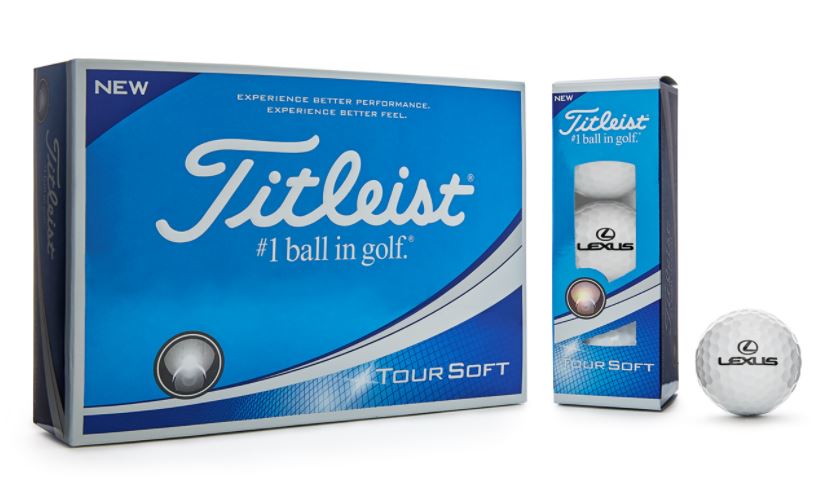
The Tour Soft balls combine an exceptionally large core with a soft cover material that almost plays as well as urethane.
We gotta hand it to Titleist for these balls. The composite ionomer cover mimics the feel and responsiveness of urethane very well.
From the tee, these balls have a soft feel and will work better for slower swing speed players with their compression rating of 65.
We were noticing a decent amount of spin whether we wanted it or not off the deck though. The side spin was really hard to check with these balls so distance was a bit compromised with our irons and hybrids.
The Tour Soft balls also performed comparably to the Titleist Pro V1X’s on the green; perhaps even better in fact. Still, the control you get on long and short shots from the fairway with the Titleist Pro V1X’s cannot be denied. The Tour Soft balls come close; but don’t quite get there.
Titleist Pro V1X Quick Facts
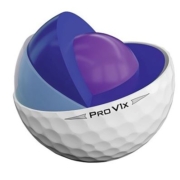
Compression: 108.4
Cover material: urethane, how many pieces: 4-piece, core material: dual-core, dimple type: spherically-tiled tetrahedral (348), spin level: low, best suited for: low handicappers, titleist tour soft quick facts.

Compression: 65
Cover material: ionomer, how many pieces: 2-piece, spin: mid/low, core material: unknown, dimple type: spherically tile (342), performance off the tee.
The better testers in our party were getting average drive distances of about 195 but they were topping out at 209!
The Titleist Pro V1X balls don’t produce much side spin off the tee which allowed for piercing trajectories that didn’t fly too high either.
Performance from the Rough
We were seeing low trajectory shots from the rough which is a good and bad thing.
It’s bad when you need to get over hazards but good for staying under trees and trying to avoid the wind.
Performance from the Fairway
We really liked the low, piercing trajectory of the Titleist Pro V1X balls with our long irons and hybrids.
Better players will be able to backspin these balls sublimely while being able to avoid low rises.
The Titleist Tour Soft actually played quite long off the tee.
The larger core made sure that no energy was lost even on faster swings and the spin rate off the tee was much lower than around the greens too.
This is where we struggled a bit with these balls.
The ionomer cover tends to bury itself in particularly tall rough.
The Titleist Tour Soft balls played pretty well from the fairway and gave pretty good bounce on long approaches, reacting well on the 2nd or 3rd bounce.
Titleist Pro V1X Selling Points
- Great for fast swing speed players
- Good greenside spin
- Low long-game spin
- Urethane cover
- Feels great
- Low trajectory
Titleist Pro V1X Cons
- Bad for beginners
- You need a fast swing speed
- Not very durable
Titleist Tour Soft Selling Points
- Good for fast swing speeds
- Plays longer
- Has a more premium feel
- Good flight
Titleist Tour Soft Cons
- More expensive
- 2-piece design
- Only available in 2 colors
- Loses its line
Who are the Titleist Pro V1X Balls for?

The Titleist Pro V1X are certainly for low handicap players who want a combination of distance and short-game control.
Keep in mind that these balls have a ridiculously high compression which will surely affect the feel from tee to pin. If you have a good swing speed though, this should be no problem.
How are They With Short Irons?
We are extremely biased towards urethane as a ball cover material. Urethane gives you an unmatched feel and softness that really comes into play when you’re dealing with a ball as firm as the Titleist Pro V1X – especially with short irons.
You get to work the ball deftly with these balls thanks to the high compression core and urethane cover.
On the Green
The roll control is there with these balls although we would say that they feel a bit dead off the putter face.
Overall Rating: 98/100
Check out more reviews here:.
Who Are The Titleist Tour Soft Balls For?
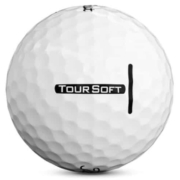
The Titleist Tour Soft balls are truly premium category balls and would work best with single digit handicaps.
More importantly, if you are swinging around 95+ MPH from the tee then you will absolutely love these balls.
Even though they have a 2-piece construction and lack a urethane cover, they yield excellent distance with fast swings.
How Are They With Short Irons?
The feedback and response of the Titleist Tour Soft balls with short irons was comparable to that of the Bridgestone E12 Soft balls.
The cover is a bit thinner than the Bridegstone balls so you get excellent feel so long as your short irons are decent.
Whether you need to work the ball on a tricky green or bite down on a fast one with some back spin, you will find that the Titleist Tour Soft can accommodate.
On The Green
You will have to get used to the Titleist Tour Soft balls a bit on the green.
They have sort of the opposite problem that the Bridgestone E12 Soft balls have in that they make you work for it if you need extended roll.
Still, the other performance factors more than make up for this shortcoming.
Overall Rating: 95/100

© 2022 Amazon Associates Program. Golf Blue Heron is a participant in the Amazon Services LLC Associates Program, an affiliate advertising program designed to provide a means for sites to earn advertising fees by advertising and linking to Amazon.com. *Amazon and the Amazon logo are trademarks of Amazon.com, Inc., or its affiliates.
- Best Golf Products
- Garmin s60 vs Garmin s40 vs Garmin s20
- Golf Driver Comparisons
- Golf Iron Comparisons
- Home Of Golf
- Putt-A-Bout Indoor Putting Mat Review

Tour Soft vs. Pro V1: Which Brand is Best for You?
In the pantheon of golf balls, there’s the Pro V1, and then there’s everything else.
The industry-leading ball has won more tournaments than Tiger Woods has had affairs and has been in the top 10% of golf balls sold for nearly two decades.
Not only that… But it also holds a major advantage over other brands: It’s a marvel by Titleist.
This means that when Nike, TaylorMade, or any other company tries to make a similar ball, they’re going up against one of the largest sporting goods companies—a David vs. Goliath battle if ever there was one.
But Titleist seems to have taken that challenge very seriously with its latest offering: The new Tour Soft.
This is a golf ball that will likely be seen on PGA Tour players’ bags soon!
In this post, we’ll compare these two big hitters head-to-head to see how they stack up against each other.
Tour Soft vs. Pro V1: Which Brand is Better?
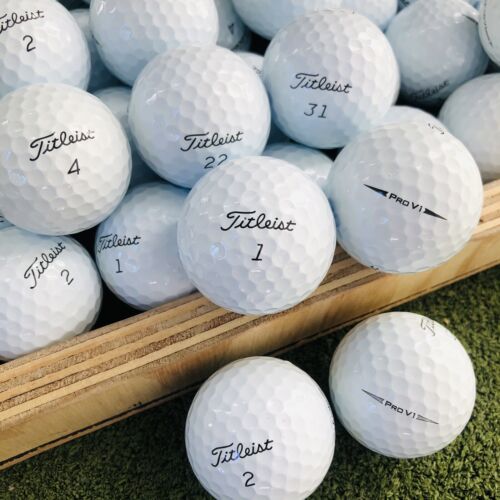
When choosing your golf ball, there are a lot of factors to consider depending on your level and aims.
One of these is durability. Unless you have a wad of cash to expend on golf balls, you will want one that can last you a while.
You’ll also want to consider the feel and responsiveness, which can affect the height and the distance you can reasonably cover.
Ball flight is also important as well as carry distance, especially if you’re interested in covering a good range with each shot.
Let’s look at each of these in turn:
Ball flight
If you’re a golfer, chances are that you’ve seen or heard of the Pro V1 and its big brother, the Tour version.
You know some distinct differences if you’ve played with either of these balls.
One of those differences is their ball flight.
The Pro V1 has an average trajectory and a high spin rate, making it more likely to stop on the green than roll off it.
In contrast, the Tour Soft’s lower trajectory and higher spin rate make for an easier-to-hit but less reliable shot into greenside bunkers or over trees in woods lines.
My opinion: This is easy. Go for the Pro V1 if you want a ball that can give you a reliable shot. Tour Soft will be a great option if you are beginner, though.
Carry distance
You may be surprised that Tour Soft and Pro V1 carry the same distance.
That’s right.
No matter how much you wish your Tour Soft would carry farther, it won’t.
The two balls have almost identical numbers in this regard.
This is another area where Tour Soft falls short of its big brother when comparing their performance characteristics…
- They’re virtually identical in both launch angle and spin rate (the latter being one of the most important factors in determining how far a golf ball carries).
The reason these two balls carry so similarly is likely due to their similar construction—both feature a urethane cover over a balata core—and their very similar low-compression cores.
Although Pro V1 has a slightly harder core.
Since Wilson Staff makes them both (Wilson Staff owns Acushnet Company which manufactures Titleist), it makes sense that they share similar design features across models.
My Opinion: There isn’t much here as you can see. Both are counterparts and up to the task so look at my opinion in the next two points.
Feel & responsiveness
You might wonder if the Pro V1 is better than a Tour Soft.
The answer: not necessarily.
While they’re both great balls, they each have unique characteristics that will help you find your perfect ball.
If you’re looking for a ball with more spin potential but don’t mind sacrificing some feel to get there, then go with the Pro V1!
The Pro V1 has a little more spin.
But it also feels less responsive and durable than the Tour Soft.
It’s also slightly softer than the Tour Soft. This means it offers more feel on mishits and has better control around the green.
- My Opinion: Feel is absolutely important. And as you can see here, the Tour Soft is the winner. If you’re like many golfers, you may not want to sacrifice feel. In which case, you may be better off with the Tour Soft.
Here’s the good news: Tour Soft will break down quicker and lose its spin sooner because of its softer cover.
Many golfers already know this to be true, but if you’re still surprised by the results, remember that it’s all about tradeoffs.
The Pro V1 has a harder cover and will maintain its performance for longer than its counterpart. But it also costs more upfront.
So, if you can afford the Pro V1 and like the durability that it offers, then it’s the better option.
However, if you don’t mind the ball going bust after a few hits and are looking to spend little, then Tour Soft is it.
My Opinion: I’ll rather go for a stronger, durable ball than one that won’t last long. I also believe it’ll save me money in the long run. And might even affect my game positively since I’m using only one ball.
Final Words: Tour Soft or Pro V1?
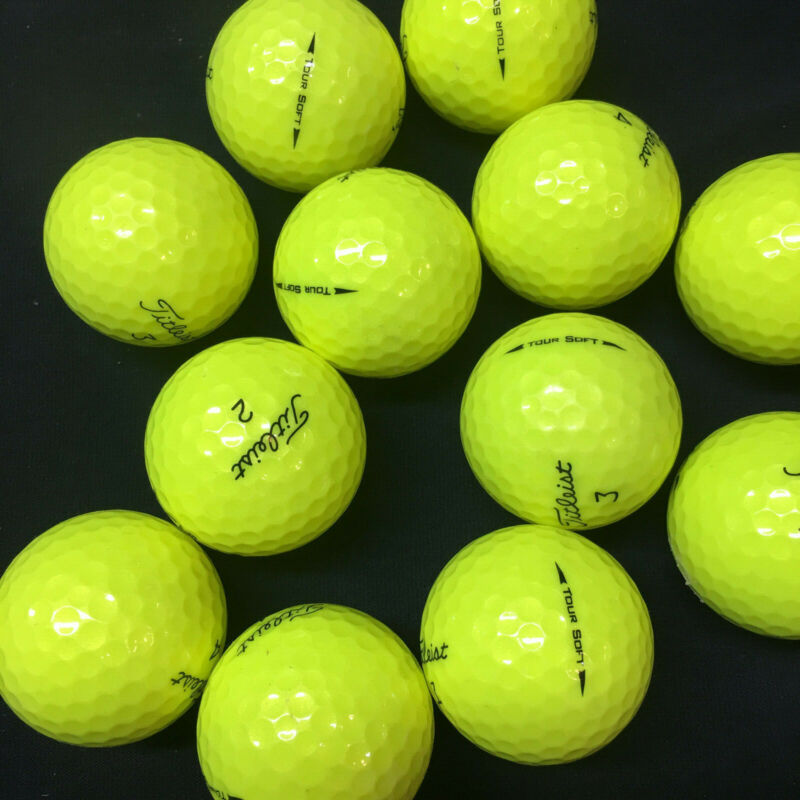
If you’re looking for an affordable alternative with all of Titleist’s legendary performance characteristics, look no further than the Tour Soft!
The Tour Soft is a great ball that gives you the same performance as the Pro V1 at a much lower price.
It’s also more durable, so you can play it in all conditions without worrying about losing distance or spin off the tee due to wear and tear.
Related Posts:
- Calcutta Golf Balls: Scam or Legit?
- Titleist AP2 vs AP3: WHICH is Better?
- Ping PLD vs Scotty Cameron: A Brief Comparison
- S400 vs. S300: Which One Is Best For You?
- Srixon Soft Feel vs AD333: How do they Compare?

Want to Get Better at Golf?
Get "ben hogan's five lessons" and join thousands of others improving their golf skills..
Learn the Fundamentals: Stance and Posture > Golf Grip > The Swing.
This book has LOADS of positive reviews. THOUSANDS OF REVIEWS. A MILLION COPY SOLD. CHEAP!
Leave a Reply Cancel reply
Your email address will not be published. Required fields are marked *
Save my name, email, and website in this browser for the next time I comment.
Tee Precision

Titleist Tour Soft vs Pro V1: Which Golf Ball Should You Choose?
As a golf enthusiast, I know that choosing the right golf ball can make all the difference in your game. Titleist is a well-known brand in the golf world, and two of their most popular balls are the Tour Soft and Pro V1. Both balls have their own unique features and benefits, but which one is right for you? In this article, I will compare the Titleist Tour Soft vs Pro V1 to help you make an informed decision.

The Tour Soft is designed to give golfers more distance and a softer feel, while the Pro V1 is built for more control and targeted at golfers with higher swing speeds who can compress the ball. Both balls have a 2-piece construction, but the Tour Soft has a larger core and thinner cover, while the Pro V1 has a smaller core and thicker cover. These differences in construction affect the ball’s spin, trajectory, and overall performance.
Whether you’re a beginner or a seasoned pro, choosing the right golf ball can have a significant impact on your game. In the following paragraphs, I will take a closer look at the differences between the Titleist Tour Soft and Pro V1 to help you decide which one is the best performer for your needs.
Overview of Titleist Pro V1 and Tour Soft
As a golf enthusiast, I have always been fascinated by the various types of golf balls available in the market. Two of the most popular ones are Titleist Pro V1 and Tour Soft. Both are manufactured by Titleist, a leading brand in the golf industry. In this section, I will provide an overview of these two golf balls and their features.
Titleist Pro V1
The Titleist Pro V1 is a premium golf ball that is designed for golfers who demand the best performance. It is a three-piece ball with a soft feel and a high compression rating of 90. The Pro V1 has a urethane cover that provides excellent greenside control and spin. It also has a high launch and low spin off the tee, which helps maximize distance.
One of the key features of the Pro V1 is its consistency. It is engineered to provide consistent ball flight and spin, which makes it easier for golfers to control their shots. The Pro V1 is also highly durable, which means it can withstand the wear and tear of regular use.
Titleist Tour Soft
The Titleist Tour Soft is a two-piece golf ball that is designed for golfers who want a softer feel and more forgiveness. It has a compression rating of 60, which makes it easier to compress and generate more distance. The Tour Soft has a 4CE Grafted cover that provides a soft feel and excellent greenside control.
The Tour Soft has a low spin off the tee, which helps golfers achieve a straighter ball flight. It also has a higher trajectory than the Pro V1, which helps it stop faster on the greens. The Tour Soft is also highly durable, which means it can withstand the wear and tear of regular use.
In conclusion, the Titleist Pro V1 and Tour Soft are two excellent golf balls that cater to different types of golfers. The Pro V1 is designed for golfers who demand the best performance, while the Tour Soft is designed for golfers who want a softer feel and more forgiveness. Both golf balls are highly durable and provide excellent greenside control and spin .
Construction and Material
When it comes to golf balls, the construction and materials used play a crucial role in determining their performance. As an avid golfer who has extensively used both the Titleist Tour Soft and Pro V1 golf balls, I can confidently say that both balls are designed with high-quality materials and construction.
The Titleist Tour Soft golf ball is a 2-piece construction with a 4CE grafted cover that provides a soft feel and excellent greenside performance. The cover material is made of a high-performance ionomer, which helps to enhance its durability and resistance to scuffs and scratches. Additionally, the larger core design of the Tour Soft ball helps to create a higher ball speed and a lower spin rate, making it ideal for golfers who want more distance off the tee.
On the other hand, the Titleist Pro V1 golf ball is a 3-piece construction with a urethane cover that provides a soft feel and excellent control around the greens. The cover material is made of a high-performance urethane, which helps to enhance its durability and spin performance. The Pro V1 ball also features a larger core design that helps to create a higher ball speed and lower spin rate, making it ideal for golfers who want more distance off the tee.
In terms of golf ball design, both the Tour Soft and Pro V1 balls feature a similar dimple pattern that helps to reduce drag and provide a more consistent ball flight. However, the Pro V1 ball has a slightly higher trajectory and a higher spin rate, making it more likely to stop on the green than roll off it. In contrast, the Tour Soft ball has a lower trajectory and a higher spin rate, making it easier to hit but less reliable in greenside bunkers or over trees in woods lines.
Overall, both the Titleist Tour Soft and Pro V1 golf balls are designed with high-quality materials and construction that provide excellent performance and feel. Whether you prefer the softer feel and greenside control of the Pro V1 or the longer distance and lower spin rate of the Tour Soft, both balls are excellent choices for golfers of all skill levels.
Performance Analysis
When it comes to performance, both the Titleist Tour Soft and Pro V1 golf balls are top performers. I have used both golf balls and found that they offer exceptional performance in terms of distance, spin, and control.
In terms of distance, the Pro V1 is known for its exceptional driving distance. It has a high compression rating of 90, which means that it is designed for golfers with high swing speeds. On the other hand, the Tour Soft has a lower compression rating of 60, which makes it a great option for golfers with slower swing speeds who want to maximize their distance.
When it comes to spin, the Pro V1 has a higher spin rate than the Tour Soft. This makes it a great option for golfers who want more control over their ball flight. However, the Tour Soft has a lower spin rate, which makes it easier to hit straighter shots.
Both golf balls offer excellent greenside performance, with the Pro V1 providing better control and the Tour Soft providing a softer feel. The Pro V1 is also known for its low spin, which makes it a great option for golfers who struggle with side spin.
Overall, both the Titleist Tour Soft and Pro V1 golf balls are excellent options for golfers looking for exceptional performance on the course. It ultimately comes down to personal preference and what you are looking for in a golf ball.
Comparison of Feel and Responsiveness
When it comes to comparing the feel and responsiveness of Titleist Tour Soft and Pro V1 golf balls, there are a few factors to consider. Both balls feature a urethane elastomer cover that provides a soft feel and great spin control around the greens. However, there are some key differences in compression and design that can impact the overall feel and responsiveness of each ball.
As someone who has played with both the Tour Soft and Pro V1, I can confidently say that the Pro V1 has a slightly firmer feel off the clubface, which can translate to a more responsive and consistent ball flight. The Pro V1’s higher compression (90) compared to the Tour Soft (60) can also contribute to a more solid feel and better feedback on shots.
That being said, the Tour Soft’s lower compression can make it easier to compress the ball and generate more distance, especially for players with slower swing speeds. The Tour Soft also has a slightly larger core and thinner cover design, which can contribute to a softer feel and more spin on short game shots.
Overall, both the Tour Soft and Pro V1 offer excellent feel and responsiveness, but the Pro V1 may be a better option for players who prioritize a more consistent and responsive ball flight, while the Tour Soft may be a better fit for those who want a softer feel and more spin around the greens.
In summary, the feel and responsiveness of the Titleist Tour Soft and Pro V1 golf balls can vary based on factors such as compression and design. While the Pro V1 may offer a more consistent and responsive ball flight, the Tour Soft’s lower compression and softer feel may be a better fit for some players. Ultimately, the choice between these two balls comes down to personal preference and individual playing style.
Suitability for Different Golfers
As a golfer, choosing the right golf ball can make a huge difference in your game. When it comes to Titleist Tour Soft vs Pro V1, both balls are great options, but they have different features that make them suitable for different types of golfers.
For golfers with a lower handicap, the Titleist Pro V1 may be the better option. It has a higher compression, which allows for more control and a better feel around the greens. On the other hand, the Titleist Tour Soft is a great option for golfers with a higher handicap. It has a lower compression, which makes it easier to compress and get the ball in the air.
If you are a beginner, the Titleist Tour Soft may be the better option for you. It is a softer ball that will help you get more distance and accuracy off the tee. The lower compression also means that it is easier to compress the ball, which can help you get more distance.
Both the Titleist Tour Soft and Pro V1 are used by professional golfers on the PGA Tour. However, the Pro V1 is the more popular ball among professionals. It has a higher compression, which allows for more control and a better feel around the greens. It also has a lower spin rate, which can help with accuracy off the tee.
Ultimately, the choice between the Titleist Tour Soft and Pro V1 comes down to personal preference. If you prefer a softer ball that is easier to compress, the Tour Soft may be the better option for you. If you prefer a ball with more control and a better feel around the greens, the Pro V1 may be the better option.
In summary, the Titleist Tour Soft vs Pro V1 comparison boils down to personal preference and the golfer’s skill level. Both balls have their unique features that make them suitable for different types of golfers.
Comparison in Use of Equipment
When it comes to choosing between the Titleist Tour Soft and the Pro V1, it’s important to consider how they perform with different golf equipment. Here’s my experience with both balls:
Off the tee, both balls perform exceptionally well. The Pro V1 has a slightly higher launch angle and lower spin rate, which results in more distance. However, the Tour Soft still provides a good amount of distance and accuracy.
With irons, the Tour Soft really shines. Its softer feel and higher spin rate allow for better control and stopping power on the green. The Pro V1, on the other hand, has a lower spin rate and may not hold the green as well as the Tour Soft.
Both balls roll true and consistently with a putter. However, the Pro V1 has a slightly firmer feel, which some golfers may prefer.
Around the greens, the Tour Soft has a softer feel and higher spin rate, making it easier to control chips and pitches. The Pro V1 still performs well, but its lower spin rate may require more precision.
Golf Equipment
Overall, both balls are high-quality options and will perform well with a variety of golf equipment. However, the Tour Soft may be a better choice for golfers who prioritize a softer feel and better control, while the Pro V1 may be a better choice for those who prioritize distance and consistency.
In conclusion, the Titleist Tour Soft and Pro V1 are both excellent golf balls, and the choice between the two ultimately comes down to personal preference and playing style.
Durability and Longevity
When it comes to golf balls, durability and longevity are crucial factors to consider. As a golfer, I want a ball that can withstand the wear and tear of multiple rounds without losing its performance. In this section, I will compare the durability and longevity of the Titleist Tour Soft and Pro V1 golf balls.
Both the Tour Soft and Pro V1 have a durable cover that can withstand the impact of clubface and prevent scratches and scuffs. The Tour Soft has a 2-piece 4CE grafted cover, while the Pro V1 has a 3-piece urethane cover. The Pro V1’s cover is slightly thicker and more durable than the Tour Soft’s cover, making it a better option for golfers who play frequently.
Another factor that affects the durability of golf balls is the dimple pattern. The Pro V1 has a 352 tetrahedral dimple design that enhances its aerodynamics and reduces drag, resulting in longer and straighter shots. The Tour Soft, on the other hand, has a 342 cuboctahedral dimple design that provides a penetrating ball flight and more control around the greens.
In terms of longevity, both the Tour Soft and Pro V1 can last for several rounds if properly taken care of. Golfers should avoid hitting the balls on hard surfaces or using them in extreme weather conditions, as these factors can affect their performance and lifespan.
Overall, the Pro V1 is a more durable and long-lasting golf ball than the Tour Soft. However, the Tour Soft’s dimple design and soft feel make it a great option for golfers who prioritize control and precision over distance.
Price Comparison
When it comes to the price comparison between Titleist Tour Soft and Pro V1, there are some differences that are worth noting. As premium golf balls, both of these options are more expensive than some of the other golf balls on the market, but they are also known for their quality and performance.
Personally, I find that the Pro V1 is slightly more expensive than the Tour Soft, but the difference is not significant. Depending on where you purchase them, you can expect to pay anywhere from $40 to $60 for a dozen Pro V1 golf balls and around $30 to $40 for a dozen Tour Soft golf balls.
While the price difference may not be huge, it is still something to consider if you are on a budget. If you are looking for a more affordable option, there are certainly other golf balls on the market that are less expensive than these premium options.
That being said, if you are willing to invest in a higher quality golf ball, both the Tour Soft and Pro V1 are great options. They are known for their exceptional performance and are favored by many professional golfers.
Overall, the price comparison between Titleist Tour Soft and Pro V1 is not a major factor to consider when making your decision. Instead, focus on the performance and feel of each golf ball to determine which one is the best fit for your game.
Other Titleist Golf Balls
As a golfer, I know that Titleist is a trusted brand for high-quality golf balls. In addition to the Pro V1 and Tour Soft golf balls, Titleist offers a variety of other golf balls to meet the needs of different players. Here are some of the other Titleist golf balls that you might consider:
- Pro V1x : The Pro V1x is similar to the Pro V1, but it has a slightly firmer feel and a higher trajectory. It also produces more spin on iron shots and has a slightly different dimple pattern. If you’re looking for a ball with a bit more distance and a higher ball flight, the Pro V1x might be a good choice.
- AVX : The AVX is a premium ball that is designed to provide a softer feel and lower ball flight than the Pro V1 and Pro V1x. It also has a slightly lower spin rate, which can help you hit more fairways and greens. If you’re looking for a ball that can help you control your ball flight and spin, the AVX might be worth trying.
- Velocity : The Velocity is a distance ball that is designed to provide maximum ball speed and distance. It has a soft core and a thin cover, which help to produce a high ball speed and low spin rate. If you’re looking for a ball that can help you hit longer drives, the Velocity might be a good choice.
- TruFeel : The TruFeel is a low-compression ball that is designed to provide a soft feel and good distance. It has a low spin rate, which can help you hit straighter shots and reduce your slice or hook. If you’re looking for a ball that is easy to compress and provides a soft feel, the TruFeel might be a good option.
Overall, Titleist offers a range of golf balls to suit different playing styles and preferences. Whether you’re looking for a premium ball like the Pro V1 or a distance ball like the Velocity, there’s likely a Titleist ball that will meet your needs.
After comparing the Titleist Tour Soft and Pro V1 golf balls, I can confidently say that both are high-quality options for golfers of all skill levels. Each ball has its unique features and capabilities, making them suitable for different types of players.
If you’re looking for a ball with a softer feel and lower compression rating, the Tour Soft is an excellent choice. It provides a good balance of distance, accuracy, and control, making it ideal for players who want to improve their aim. Additionally, the two-piece golf ball construction of the Tour Soft enhances its durability, making it last longer.
On the other hand, if you’re looking for a ball with a higher spin rate, the Pro V1 is the way to go. It provides a more consistent trajectory and is more likely to stop on the green than roll off it. The Pro V1 is a premium ball that offers excellent performance and forgiveness, making it a favorite among professional golfers.
If you’re looking for a ball that combines the best of both worlds, the Titleist Tour Speed is an intriguing option. It seems to blend characteristics of both the Pro V1 and Tour Soft to create something in the middle. The Tour Speed ball offers a good balance of distance, control, and spin, making it suitable for a wide range of players.
Overall, the choice between the Titleist Tour Soft and Pro V1 ultimately comes down to personal preference. Both balls offer excellent performance and are worth considering. When choosing a ball, it’s essential to consider your skill level, playing style, and budget to find the best fit for you.
- Recent Posts
- Should Tee Boxes Be Level? - January 23, 2024
- 3 Hybrid Distance - November 15, 2023
- Innovations in Golf Mobility: An In-depth Review of Top Golf Scooters - October 12, 2023
- Fairway Woods
- Golf Wedges
- Golf Technology
- Golf Gloves
- Golf Apparel
- Golf Accessories
- We Tried It
- Head-to-Head
- True Golf Fit
- Our Toolkit

Titleist Tour Speed and Tour Soft Golf Balls
- BY Tony Covey
- May 19th 2022
- Read all comments
Support our Mission. We independently test each product we recommend. When you buy through our links, we may earn a commission.

- Titleist has introduced new versions of Tour Speed and Tour Soft .
- Tour Speed is “reformulated”; Tour Soft is billed as “new.”
- Retail price in the U.S. is $40 (Tour Speed) and $35 (Tour Soft).
- Available May 20

The original Titleist Tour Speed golf ball launched in August of 2020. Given the cadence of the industry, a late May release might suggest Titleist is coming to market a little early with Version 2.0. The thing is … This Tour Speed isn’t really a Version 2.0. According to Titleist, it’s not technically new. It’s reformulated which I suppose could make it Version 1.5. But, early to market? Definitely not. For Titleist, the reality is closer to just in time .
Before we dig into all that, let’s briefly explore the nearly-as-brief history of Tour Speed.

A Brief History of Titleist Tour Speed
Tour Speed is Titleist’s entry into the “not played on Tour” urethane market. While there is the occasional exception, we’re talking about balls used almost exclusively by recreational golfers, and moderate swing speed ones at that. It’s a competitive set that includes things like Chrome Soft, Tour Response and the Bridgestone RX series.
Beyond filling a niche in the market, Tour Speed is notable for Titleist in that it’s the first (and only) ball in the lineup to use a TPU (thermo-plastic urethane) cover. Pro V1 and Pro V1x, as well as AVX, leverage cast-urethane cover technology.

We can save the cast-versus-TPU cover conversation for another day but, within the Titleist ecosystem, TPU (which is has co-opted as Titleist Performance Urethane ) is good but cast urethane is better. It’s a good bit of the reason that justifies the cost difference between Tour Speed and Titleist’s other urethane offerings.
From a performance perspective, Tour Speed trends toward lower-spinning. That’s common for balls playing in the same space. While not among the lowest-compression balls in its space, at around 78 compression, it’s soft by Titleist urethane standards.
That higher relative compression along with a 346 quadrilateral dipyramid dimple design (that won’t be on the test) makes for a surprisingly long golf ball that proved one of the biggest eye-openers in our 2021 ball test .

Titleist Tour Speed in the Marketplace
It should go without saying that Tour Speed isn’t the top-selling ball in the Titleist lineup. Its numbers are closer to AVX which is to say it isn’t a juggernaut but it’s enough that it would be the top-selling ball in some competitors’ lineups. It has an audience that Titleist believes is growing. Better still (for Titleist, anyway), the Tour Speed converts aren’t moving down from Pro V1; they’re moving up from an ionomer-covered ball or moving over from competitors’ offerings.
Why? Golfers—at least some golfers—really like Tour Speed.
When Titleist surveyed Tour Speed users, they found 75 percent were satisfied with the product. An equal percentage said they either play Tour Speed exclusively or as one of the two or three balls they play regularly.
All of this is a round-about way of saying that, for Titleist, it’s good to have Tour Speed in the lineup.
And that, my friends, brings us to the realities of the world right now.

Supply Chain Challenges
As you’ve heard, the global supply chain remains in chaos. Depending on where you live and what your golf ball of choice is, you may or may not have felt the effects of an ionomer shortage.
Ionomer is the cover material of choice for two-piece golf balls. It’s also used in the casing/mantle layers of three-, four- and five-layer options. The bottom line is there’s a lot of overlap industry-wide with suppliers, those suppliers are spread thin and, much as you might like to, you can’t make a golf ball without ionomer.
Ball manufacturers are dealing with the shortage in different ways. Some are simply making fewer of everything. Others are shifting the bulk of production to their biggest sellers. In some regions, models are disappearing from shelves and DTC brands are feeling the pinch as overseas factories allocate the bulk of their materials to larger customers.
Despite its strength in the market, Titleist is feeling the pinch, too.
It doesn’t need to be said but, with allocations already tight, cutting production of Pro V1 is a non-starter. Still, Titleist didn’t want to pause production on Tour Speed. The future of the ball is too bright for it to disappear from retail shops. Faced with a difficult decision, Titleist decided to reinvent … or reformulate.

A Reformulated Titleist Tour Speed
The story of the reformulated Tour Speed isn’t that it’s longer. It doesn’t fly higher. You also shouldn’t expect any additional greenside spin. It’s not even softer.
Despite an entirely new core formulation and an entirely new mantle formulation and, I suppose, in spite of that 346 quadrilateral dipyramid dimple design, golfers should expect the reformulated Tour Speed to perform identically to the old Tour Speed.
I know. We’ve all come to expect that newer is longer. Newer spin more. Newer almost always feels softer so “ newer is the same ” isn’t much of a sales pitch but let’s look at it from Titleist’s perspective.
To achieve performance parity with the original Tour Speed, it had to find new materials and new suppliers. It also had to qualify the new suppliers (their factories and their machinery) to ensure the materials they deliver are the same every time. Titleist had to develop entirely new chemistries and compositions that deliver the requisite performance.
Sometimes breaking even is a feat of engineering.

It’s what the company calls “doing right by the golfer” and, to put it in perspective, imagine your favorite restaurant trying to recreate a popular dish using an entirely different set of ingredients.
That’s essentially what Titleist did in reformulating Tour Speed.
So, yeah, the reformulated Tour Speed isn’t “better.” It’s almost entirely different but should perform the same. Innovation and improvement are temporary casualties of the supply chain but that’s what it took to keep Tour Speed on the shelves.
Pricing and Availability
Retail price for a dozen of the reformulated Titleist Tour Speed is US$40. Retail availability begins May 20. The U.S. market will be limited to white only until June 21. In other markets, yellow will be available at launch.
Titleist Tour Soft

The new Tour Soft is the third generation of Titleist’s entry in the premium ionomer market. If you want the absolute softest ball in the Titleist lineup, you want True Feel but Tour Soft is designed to appeal to the feel-driven golfer looking to retain a little bit more speed and some greenside spin.
The story of the new Tour Soft is almost entirely about the cover and a good bit of that is driven by the core.
At 1.600 inches, Tour Soft has what amounts to a massive core. USGA rules say a ball has to be at least 1.680 inches in diameter and, generally speaking, manufacturers want to be as close to that limit as possible. Smaller is typically longer so, it doesn’t take a rocket scientist to figure out that Tour Soft needs a really thin cover.

In this case, Titleist is using its 4CE-grafted cover with a 345 quadrilateral dipyramid dimple design. I should be clear: this 345 quadrilateral dipyramid dimple design isn’t the same as the 345 quadrilateral dipyramid dimple design that’s used on the Tour Speed.
Your fun fact of the day: Titleist has seven different 345 quadrilateral dipyramid dimple designs in its library. One worked well for Tour Speed, another just happened to work surprisingly well for Tour Soft.
From a performance standpoint, the Tour Soft should fly lower than Tour Speed . It will likely feel softer but, because of the ionomer, you’ll likely find it spins less around the green.

Retail price for the new Titleist Tour Soft is US$35 a dozen, available May 20 in both white and yellow.
For more information on Tour Speed and Tour Soft golf balls, visit Titleist.com .

Apr 8, 2024
Public vs private: where to play in 2024.


Apr 7, 2024
Testers wanted: ghost golf anyday golf bag.

Apr 6, 2024
Testers wanted: l.a.b. df3.
- about the author
- latest posts

Tony is the Editor of MyGolfSpy where his job is to bring fresh and innovative content to the site. In addition to his editorial responsibilities, he was instrumental in developing MyGolfSpy's data-driven testing methodologies and continues to sift through our data to find the insights that can help improve your game. Tony believes that golfers deserve to know what's real and what's not, and that means MyGolfSpy's equipment coverage must extend beyond the so-called facts as dictated by the same companies that created them. Most of all Tony believes in performance over hype and #PowerToThePlayer.
Email Address
2 years ago
Good article. Titleist just sent me a free sleeve of Tour Speed balls to test and then comment on in a survey. I received some Bridgestone RXS balls as a gift earlier this year, so I’ll have to see how they compare. I know MyGolfSpy says that the lower compression balls don’t go as far, but I’m a senior citizen, so things are slowing down anyway, and I like the softer feel.
Does anyone else think there is just too much choice when it comes to golf balls? I think you could probably find a ball (for you) in just about every manufacturer’s stable, not to mention the numerous DTC choices. With all these popup DTC vendors that provide balls within a whisker of the performance of the big OEM’s balls, I would suspect that this is having an impact on their sales. Of course, some people believe that there is some level of comfort in playing a ProV1 or Chrome Soft. Perhaps there is, but only for the committed recreational golfer. For the casual recreational golfer, they’ll probably buy the cheapest ball they can find and not give it a second thought.
In no way am I saying titleist golf balls are bad, but having had multiple discussions with sales reps and upper management over the years, when I ask them why do you say the pro v1, v1x is the best ball for all golfers, and then make all these other balls. The exact response was always, because some people just don’t want to play the best ball for them…. My response was always maybe some people just don’t want to spend $50.00 a dozen. haha
As I’ got older, I became cheaper and looked for golf balls below the cost of the Pro V1. I tried Snell Black, OnCore Elixr, Srixon QStar Tour and Tour Response. All were OK but nothing special. At the beginning of this year I tried the Titleist Tour Speed. What a difference that ball made to my game! It felt great, the distance was longer than any ball I’d played, it spun when I wanted it to and the cover held up beautifully. I am sold. It’s a terrific Titleist and I have confidence in its quality. If they don’t change it, that will be OK with me. As a bonus, the alignment arrow is great for putting. $40 is a very fair price for this ball. It is worth it and more.
Appreciate the insight, that was a good article. I have not played the tour speed but have played the tour soft. I definitely feel that due to the lower spin I squeezed out a few more yards vs my usual urethane balls. But I’m not a fan (so far) of the tour soft around the greens. The isonomer cover doesn’t check up well & it also feels really hot off the putter. I would have to test more to determine if the increased yardage off the tee is worth less control around the greens (probably not.). Bottom line, with all the other DTC & eBay availability of urethane balls, I wouldn’t buy new tour speeds at the stated price, & since I miss a fair amount of greens & thus I’m pitching/chipping a lot, the tour soft may not be optimum for me around the greens.
Do I understand it correctly that it is a cheaper “recipe” for the same price? I understand the motivation of Titleist, but not sure if I should be happy with it…
Can´t wait for your comparison article!
Not cheaper, rather than continue to use raw materials that would not be available due to supply chain issues, they reformulated the ingredients that would allow them to produce balls. If Titleist kept the same “recipe”, they would not have had enough materials to produce the amount of balls they wanted to.
Always appreciate insight into composition and expectations on new balls.
Titleist makes good stuff.
Yeah not gonna be playing either of these. Played the Tour Soft a bit in ’20 didn’t like it, so if it’s the same, there’s no point.
Too expensive as long as Snell balls are available.
I do hope The Tour Speed holds up. I am a convert from the 2-{piece crowd (Titleist Velocity) looking for an upgrade, and realizing AVX and Pro V1 were still out of my league. I love The Tour Speed First Generation, and have about 6 dozen back up to see me through for a bit. I’ll be the first to tell Titleist that The Tour Speed is a great ball for the mid-capper looking to go lower, and beginning to learn to steer the ball without losing distance.
This is an amazing amount of detail for two balls that I don’t ever really think about. I really appreciated the analysis around why the Tour Soft is still the same ball but reformulated due to supply chain and manufacturing issues. Cool article, actually.
Leave A Reply
Notify me of followup comments via e-mail
Sign me up for the newsletter
This site uses Akismet to reduce spam. Learn how your comment data is processed .
Titleist ProV1 Golf Balls


Get plugged in…

2021 Titleist Pro V1 & Pro V1x Golf Ball Review
More in reviews:.

50 Words or Less
The 2021 version of the Titleist Pro V1 and Pro V1x maintain the same outstanding performance of previous generations. Pro V1 feels slightly softer. Slightly higher short game spin in both models.
Check out our review of the 2023 Pro V1 and Pro V1x HERE
Introduction
To say that the Titleist Pro V1 is the #1 ball in golf doesn’t really go far enough. The Pro V1 has been the undisputed king for so long that many people reading this may not know that any other ball was ever #1. But this dynastic success hasn’t kept Titleist from continuing to push the envelope. The latest version features a new core, casing, and cover to push its performance to even higher levels.
When comparing the 2017 and 2019 versions of the Pro V1 and Pro V1x, I came up empty in terms of finding any differences in feel. With the 2021 version, I was more successful, but I’ll start by stressing that these differences are very small. I found them by hitting dozens of putts back and forth with each model. Unless you claim to have Tiger-like feel, I doubt you’ll notice any difference on the course.
With all that said, I think that the 2021 Titleist Pro V1 is slightly softer than the previous version . The overall character is still the same – premium, soft without being mushy – but impact sounds a little quieter and the ball feels like it’s on the face just a little longer.
To me, the new Pro V1x feels identical to the older generation. Comparing the Pro V1 to the Pro V1x, the X is decidedly firmer. Impact with the Pro V1x has a “tock” sound where the Pro V1 is a “thud.”
One of the major talking points around the new versions of the Pro V1 and Pro V1x is the new urethane elastomer cover. Titleist states that this is the softest formulation ever used in these balls, and that should lead to more greenside spin.
In my launch monitor testing, I saw both models spinning about 100 RPM more than the previous generation . As always, please keep in mind that I tend to be a low spin player, so you may see larger spin gaps.
On the launch monitor, both the Pro V1 and Pro V1x performed very similarly to the previous generation . Given that the 2019 versions were great, this isn’t a complaint whatsoever. I saw the Pro V1x producing slightly higher spin in the irons and the Pro V1 creating a more penetrating flight. Both carried plenty of spin to hold a green.
With the driver, both golf balls produced very high ball speed and consistent launch conditions . Again, the Pro V1x spun a little more, though the gap was only about 200 RPM for me.
The one element that I have not been able to test is the new dimple pattern . Each ball has a new tetrahedral dimple design – 388 on the Pro V1, 348 on the Pro V1x – to improve its aerodynamics. As the weather improves, I’ll be interested to see if there’s a visible difference in the ball flight with this new pattern compared to the older one.
Whether you opt for the boring trajectory of the Pro V1 or the higher ball flight of the Pro V1x, you’ll find a little bump in spin around the green with the latest versions. While the #1 ball in golf will continue to be one of the most expensive, knowing that you’ll have the pinnacle of consistency from shot to shot may be worth it for the serious players.
Visit Titleist HERE
Recent posts.
- Edel Array F-2 Putter Review - April 11, 2024
- Tour Edge Hot Launch C524 & E524 Irons Review - April 10, 2024
- Mitsubishi Diamana Putter Shaft Review - April 9, 2024
17 Comments
Thanks, Matt. If you are like me, a bit older with a no doubt slower swing speed than yours, is there a discernable difference between the Pro V1 and the X in this regard? Or to an even greater extent, should a slower swing player play a different Titleist (or other brand) altogether? Thanks, as always.
It depends on your ball fitting/selection philosophy. Titleist promotes “Start at the green,” so they’ll say that everyone who wants soft feel and wedge spin should play a Tour ball. Bridgestone starts the fit with the driver, so they focus more on different compressions, it’s why they have 4 Tour-style balls, etc.
Matt—thank you for your reviews as always.
Question–I had the opportunity to get a Titleist fitting. I was playing the AVX and after my fitting they recommended the left dash pro v1X. Have you done a review of the new AVX and the left dash?
I reviewed the most recent AVX here: https://pluggedingolf.com/2020-titleist-avx-golf-ball-review/
I have not tested the Left Dash Pro V1.
I play left dash Pro V1x after careful research and A LOT of testing. Left Dash is much firmer than AVX. It is firmer than any other ball I’ve tried, frankly, other than perhaps TP5x. I am a high speed, high spin player and needed spin reduction on mid and short irons but wanted to maintain that spin around the greens and on wedges. Left dash does all of that. I found AVX to be significantly shorter on Driver swings, likely due to it’s much lower compression (I usually get 170+ ball speed and was seeing 165 or less with AVX, 172 or more with Left Dash… big difference). Lastly, left dash is the best ball I’ve ever putted with. Standard tour balls are also good, but I find putting with a firmer ball helps me personally. I feel like I don’t have to mash it to get it going, especially on “average” greens I usually play.
Long story short, AVX is low launch, low spin – ProV1 is mid-launch, mid-spin – ProV1x is high-launch, high-spin and Left Dash is High-launch, low-spin. Perfect for me.
Could you test the Snell golf balls ? I play the MTB Black . These are the best golf balls I have ever played. Great feel and distance I’m 70 years old and fine these golf balls perform the best for me .
I will reach out to Snell to see if they’re interested in working with us on a review.
How is the durability for us ball strikers who, um, catch a few shots thin?
Also, how does this compare to the Snell MTB-black (V1 ) and MTB-X (V1x)?
The durability is as good as any Tour ball I’ve used.
I haven’t tested the latest Snell balls, so I can’t offer an informed comparison.
I have never heard of the left dash. I have a lower flight trajectory and prefer a slightly firmer ball. I am looking for higher ball flight . Iusually play the Chrome Soft x. I play at a resort/club and haven’t seen the Pro V1x dash. (Don’t know where to put the dash)
I’ve been hitting these against each other on a foresight and actually find I hit the pro v1 a little higher with less spin. It’s all very similar. Comes down to feel. I have always played the pro v1 bc of the softness but I really like how the pro v1x feels. Clickier. Reminds me of the NIKE RZN premium balls.
Is there a massive difference between v1 the x and the avx
Massive? No, not in my opinion.
In your opinion, is the 2021 version of the Pro V1 and Pro V1x improved enough in feel and/or performance to choose it over the 2019 model? I buy my balls used and am trying to decide between the higher cost for 2021 vs 2019 for a bit less. Curious if the improvements are worth the higher price.
If you’ve been happy with the 2019 version, I’d probably keep playing it if it will save you a few dollars.
Matt, who do you think has it right, Bridgestone or Titleist? Do the softer compression balls really go further with slow swing speeds like mine? Would you say it comes down to whether you want a few extra yards from say a Bridgestone RX or the extra spin around the green from a Prov1x? (And its weird that Couples uses a RXS and Korda a RX when they swing well over 105 mph.
thanks, John
Last question first: I don’t think you’re giving up much/any green side spin with the Bridgestone; their cover is fantastic. Regarding slower swing speeds, my understanding is that there is some ball speed to be gained from softer compression balls. Whether it makes a meaningful, noticeable difference on the course, I don’t have that data. That does sound like a good Golf Myths Unplugged, though.
Leave a Comment Cancel
Your email address will not be published. Required fields are marked *
Email Address
Save my name, email, and website in this browser for the next time I comment.

- Skechers Slip-Ins: GO GOLF Blade GF Shoes Review
- Golf News – April 11, 2024
- Edel Array F-2 Putter Review
- Golf News – April 10, 2024
- Tour Edge Hot Launch C524 & E524 Irons Review

Contact Us Advertise Subscribe

Advertise on this site.
Plugged In Golf

Do You Like Free Golf Gear?
Sign up for our weekly newsletter and not only will you get the latest reviews, instruction, and more delivered directly to your inbox, you’ll also be entered into regular giveaways for golf clubs and more.

Titleist Tour Soft vs Pro V1: Which One Is The Best Performer?
Golf ball is the crucial equipment you need to improve your game at golf. Therefore, you need to choose a golf ball that helps build consistency and confidence while playing.
That’s why you have the Titleist golf balls, as the best golf balls are known for their all-around performance.
- Tour Soft Golf Balls ( Distance and feel in a nice ball )
- Titleist Pro V1 Golf Balls ( Best in overall performance )
- Velocity Golf Balls ( Definitely hits longer )
- Titleist Pro V1x Golf Balls ( High preforming ball )
- Titleist TruFeel Golf Balls ( The best value ball )
The Titleist Tour Soft ball comes with a thin cover and is soft enough to effectively produce a long ball with exceptional grip. But that doesn’t mean the softness can take away the control which comes from Pro V1.
Which golf ball is suitable for your game: Titleist Tour Soft vs Pro V1 ? Let’s explore how they differentiate from each other in this in-depth article.
Differences Between Titleist Tour Soft vs Pro V1
The balls, Titleist Tour Soft, and Pro V1 come with their unique features and capabilities to improve your game. Thus, it is essential to list out the differences in terms of their features and performance.

- Beginner Friendly
- Highly durable
- Affordable than other Titleist golf balls
- Offers Exceptional feel
- Improved distance technology
- Excellent Short-Game performance
- Lack greenside feel
- Suited for only faster swing speeds
Breaking it Down
It’s time to compare and find which golf ball is the winner in Titleist Tour Soft vs Titleist Pro V1 . We will compare the balls in terms of their compression, construction, distance, durability, and other features. You will find the winner at the end of each feature.

The Titleist balls offer exceptional ball attributes to help the golfers in different areas of the game. In addition to delivering superior performance, let’s discuss how they perform in different categories. If you are want to know the winner, be patient and read through the end of the article.
Construction
Construction is the vital factor that highly impacts game performance. The construction comes in two types as multi-layered and two-piece construction. The multi-layered balls have five, four, or three layers. An increase in each layer affects the overall performance of the golf ball.
Golfers with slow-swing speed , high-handicap golfers, and beginners usually prefer two-piece balls. They have a thin cover and large core that intensifies the energy transferred from the club to the ball. You have powerful shots with exceptional distance.
Fast swing speed golfers and mid-to-low handicap golfers prefer multi-layered balls. The faster swing aggravates each layer which gives you the distance you need. Let’s see how both the balls perform in this category.
Titleist Tour Soft
The Titleist Tour Soft comes with the largest Titleist core that results in an extremely thin 4CE grafter cover. As a result, you have increased short game spin and greater distance compared to previous versions.
The 4CE cover offers a decent grip but is not as responsive as that of Pro V1.
Titleist Pro V1
The Titleist Pro V1 is equipped with a secured urethane design cover that is built on previous versions. This makes sure that the ball is highly durable but also provides a softer surface for golfers. Moreover, the ball comes with the Titleist advanced printing technology offering exceptional performance from color and brightness.
Winner: Titleist Pro V1
Distance is another crucial thing to consider while looking for the best golf balls. Every golfer wants to achieve greater distance with their selected golf balls with every club in the bag. The distance has a significant impact on ball performance and helps improve your game.
The golf balls that come with thin covers and large core help generate more distance in terms of yards. The core of the ball acts like an engine that generates enough power for the ball to fly and cover a greater distance. Let’s find out among Titleist Tour Soft vs. Pro V1 is the winner of this category.
As mentioned above, the Tour Soft ball has a larger core due to which its outer cover is made thinner. Thus, it offers splendid distance and speed. Moreover, the soft ball feel offers exceptional control around the greens. Also, be sure to read more about the Titleist Tour Soft Full Review .
Mostly soft balls are not preferred for distance, but this ball performs excellent off the tee. Its low spinning flight makes the ball favorable for long drives.
When it comes to distance, there is no comparison with Titleist Pro V1. The ball is the crown jewel of Titleist that shines in this category to maximize the distance at every shot. The fast swing speed golfers will benefit from the ball as it will go off the club to reach a greater distance every time.
Compression
Another crucial element to understand the golf ball design and performance is compression. It is the force that is required to compress the ball on impact. In other words, the compression is identified by the golf ball’s hardness.
A high compression ball feels harder at impact, while the low compression ball would feel soft. Low swing speed players would prefer low compression balls, where high swing speed prefers high compression balls.
Titleist’s latest production as a low compression model is the Titleist Tour Soft golf ball. With a 60 compression rating, it is designed with a five percent larger core than any other model. Because it is a soft ball, Titleist offers more impact on the clubface and achieves greater distance.
Titleist Pro V1 falls under the category of high compression golf balls. The balls have harder cores which make them compress slowly. However, the ball is suitable for high swing speed golfers to achieve maximum distance.
Winner: Tie
Feel and Greenside Control
What do you understand by feel and greenside control? The feel comes with compression as to how does the ball feels on impact. As the club hits the ball, the ball’s shape disfigures upon impact. However, the change in shape is temporary as it pushes the ball forward after being hit with the club.
The balls with low compression disfigure more which allows the slower swing speed players to generate a powerful spring effect. It will result in straighter shots, less spin, and maximum distance.
On the other hand, high compression balls do not deform much as they require harder and faster impact to change the ball’s shape. Mostly, fast swing speed golfers use high compression balls.
With a softer feel, the ball is great for long shots, with drivers having a low spin and straight flights. In contrast, for a short game, the moderate spin and soft feel provide just enough control and grip on the greens.
The Tour Soft Ball does offer adequate control and spin around the greens. It is also noticeable that when you play wedge shots, the Tour Soft balls spin more than the Pro V1.
The Titleist Pro V1 comes with a firmer feel because of the Thermoset Urethane elastomer cover. As the club hits the ball, you can feel the impact and response, which is somewhat lacking on Tour Soft golf ball.
When it comes to greenside control, Pro V1 performs exceptionally well in terms of its stopping power and grip.
Durability and Workability
You want a golf ball that is not only durable but also provides long-lasting performance. The durability of the golf ball is directly dependent on high-quality materials like the urethane cover. Don’t forget to learn about Tour Soft Vs Chrome Soft .
You need to determine how many rounds a golf ball can last while playing a game in terms of workability. Let’s check which golf ball Titleist Tour Soft vs. Titleist Pro V1 scores best in the category of durability and workability.
Most golfers have claimed that the Tour Soft golf ball offers high durability as it shows minimal scuffing even after long hours of playing. The ball enables you to play an 18-hole golf course without getting any extreme marks.
The ball is equipped with 342 spherically tiled with cuboctahedron-designed dimples to provide a penetrating ball flight. Furthermore, Tour Soft is made as a control ball that does not deviate from bad shots and helps you carry longer because of penetrating flight.
The Titleist Pro V1’s durability is somewhat in question as many golfers claim that the ball shows scuffing marks after two rounds of the golf course. With a urethane cover, the durability is better as marks do not appear quickly, but they will still be visible compared to the more durable 4CE grafted cover of Tour Soft Ball.
In terms of workability, the Pro V1 shows exceptional performance by changing shapes and altering the ball flights as per the wind. But, it does deviate and lack control.
Winner: Titleist Tour Soft
When the ball hits the club correctly, it produces an exhilarating sound. The sound is a factor to determine whether the golfer made a great shot or not. If any golf ball doesn’t make a desirable sound with great hits, the ball is not going to survive in the golf industry.
The acoustics are not the crucial factors while looking for golf balls, but they influence the quality of the game.
Depending on how you want the softness when you hit, the Tour Soft ball produces more of a quiet and soft sound. However, it still manages to improve the distance control with low sound and an excellent putting feel.
There isn’t a Titleist ball that does not include the unique and original sound. You will find an improved and new sound of Pro V1. However, you can expect similar smooshes, squishes, and clicks upon impact.
The sound is important to boost the performance and confidence of the golfers. Because of its firm outer surface, it outperforms Tour Soft in the category of sound.
The spin helps the ball to rise and fly high in the air. The balls have dimples that act like wings of the ball to promote a higher flight. The dimples create a blanket of air around the ball which is responsible for pushing the ball further to reach a greater distance.
The balls with a high compression rate offer better spin and control in comparison to low compression balls. Now, we will inspect how Titleist Tour Soft vs. Titleist Pro V1 performs in the last category.
The Tour Soft golf ball produces consistent driver spins in the long game. When it comes to full swing wedge shots, the Tour Soft performs similar to the Pro V1.
In case you want to maximize the short game spin, Tour Soft ball should be your best option.
The balls must have great stopping power with irons so that you can have the right amount of power to hit the ball. With such reasonable power, the golf ball will spin enough in the air so that it stops as soon as it hit the greens after a long shot.
For short game too, the ball responds exceptionally well to all the club impact to boost confidence in the players,
The winner of Titleist Tour Soft vs Pro V1 is none other than Titleist Pro V1 . The ball is superior in all categories except for workability and durability. Pro V1 offers exceptional stopping power and excellent performance around the greens. Moreover, it is best suited for mid to low handicappers .
If you want to go by the price, Titleist Tour Soft is an affordable option. Though both the balls offer a decent low spin rate off the tee and from a distance, the better performing ball is Pro V1.
Related Posts
- TESTED: Callaway Hex Tour Soft Review – Costco 2021 Updated!
- TaylorMade TP5 vs TP5x vs TP5x Pix Review 2021 – Are They Different?
- Titleist Pro V1 vs Pro V1x vs AVX Review 2021: The Game Changers!
Last update on 2022-04-03 at 13:20 / Affiliate links / Images from Amazon Product Advertising API
3 Million Annual Readers >
2,300+ Products Tested >
300+ Reviews Completed >
Titleist Pro V1 vs Pro V1x: What’s the Difference?
The Titleist Pro V1 and Pro V1x golf balls deliver outstanding game play for golfers of all skill levels.
The two balls deliver penetrating ball flight and high short game spin, but each model provides specific benefits that players can utilize on the links.
Users of the Pro V’s among PGA Tour players include two-time major winner Justin Thomas , Jordan Spieth , and Adam Scott.
In our Titleist Pro V1 vs Pro V1x review, we’ll take a look at what makes each ball unique, which ball works best for your game, and why these two balls are a favorite among tour pros.
Titleist Pro V1 vs Pro V1x 2023 Review
Titleist pro v1 golf balls.
Best All Around Golf Ball

Specifications
- Category: Distance
- Launch: Mid-to-High
- Driver Spin: Low
- Wedge Spin: High
- Lower controllable mid-range flight
- Low driver spin equals more distance
- High greenside spin for shot-stopping power
- Relatively expensive golf ball for casual golfers
Comparing the Pro V1 and Pro V1x, the Pro V1 offers the most accessibility between the two golf balls, helping the largest number of casual players.
By producing lower rotation from the tee box and with longer irons, the Pro V1 increases accuracy for the players that need it the most.
While the Pro V1 and Pro V1x are both great golf balls, the V1 version flies farther, spins less, and maintains a tight dispersion, helping players hit more fairways to help increase their ability to post lower scores.
Around the greens, the regular V1 version also offers high rotation with a softer feel to increase responsiveness.
Although the Pro V1 comes with a high price tag for a casual golfer, the benefits provided to the mid and high handicapper deliver outstanding value.
Titleist Pro V1x Golf Balls
Best High Spin Golf Ball

- Launch: High
- Higher ball flight with more iron spin
- Firmer feel provides immediate feedback
- Penetrating ball flight provides a steep landing angle
- Better for precision players that don’t mind a higher spin rate
Between the Pro V1 and Pro V1x golf balls, the V1x model offers more control and precision, a perfect combination for advanced players and tour pros.
It also delivers some of the highest spin rates from a top-tier golf ball, making it a weapon for playing around the greens.
While some PGA Tour players don’t like the increased rotation produced by the Pro V1x, most low handicappers like the control the V1x provides their game from the fairway and around the green.
Inexperienced players could find the V1x too erratic because of its high spin rates, but that is more of an indictment on their skill set than the golf ball itself.
When choosing between the Pro V1 and Pro V1x, the V1x definitely plays to the strengths of the skilled golfer.
Titleist Pro V1 vs Pro V1x Comparison
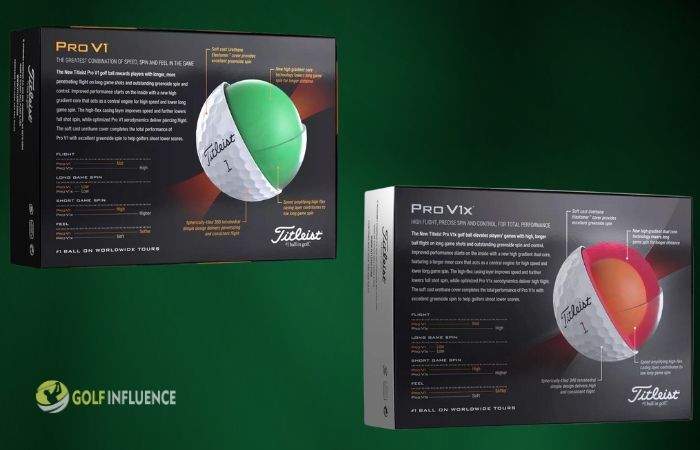
Frequently Asked Questions
Should i use pro v1 or pro v1x.
For mid and high handicappers , the Pro V1 golf ball offers a very soft feel around the greens, plus the solid core produces high speed to help maintain distance from the tee box. The Pro V1 also provides more distance.
If you are a low handicapper who prefers higher spin with a slightly firmer feel, the Pro V1x remains the best ball to play with at your local golf club.
Do Pro V1 balls go further than Pro V1x?
Yes, on average the Pro V1 travels further than the Pro V1x, but that’s an intentional feature from Titleist.
The golf equipment company developed the V1x to generate more spin for players with faster ball speeds that want more control with their longer clubs.
So, PGA Tour players can work the Pro V1x with more authority because it produces reliable distance and consistent spin, even if it comes with higher ball flight on longer shots.
For amateurs , the Pro V1 is the right golf ball for their skill set because it delivers more length with a softer feel around the greens.
Should a mid handicapper use a Pro V1x?
A mid handicapper would benefit more from playing the standard Pro V1 over the Pro V1x.
While both are great golf balls, mid handicappers usually carry lower swing speed and need lower spin from the tee box to maintain shot dispersion. Those two traits are specific to the Pro V1.
The Pro V1x also produces a higher trajectory and, for many golfers, lower height helps keep the ball on the fairway and reach more greens with the short irons.
What swing speed is needed for Pro V1x?
The higher the swing speed, the better for the Pro V1x. For low handicappers that hit golf balls with their driver over 160 mph, the Pro V1x delivers an added layer of workability to help them shoot lower scores.
Since the Pro V1x delivers more spin than the Pro V1, Titleist golf ball users with high swing speeds can also work the shot higher to steepen the landing angle and boost the ball’s stopping power on the green.
While players with lower ball speeds can utilize the Pro V1x, since these balls qualify as a higher spinning ball, the golfer will need precision and control to keep the ball along the target line.
Our Verdict
For our money, the best golf ball on the market is the Titleist Pro V1. It offers the most accessibility to the largest group of players.
With a low penetrating trajectory and low long game spin, the Pro V1 will help weekend warriors find more control off the tee box and from the fairway.
If you are an experienced golfer who values workability, the Pro V1x golf balls deliver high spinny shots with much control.
The ball is as good as the Pro V1, but its slightly firmer feel and more penetrating ball flight works better for skilled players, especially when using short irons .
Titleist Pro V1 vs Pro V1x: Differences, Pros, Cons
Fact Checked By Ben Jenks
Pro V1 vs Pro V1x: Verdict
Pro v1 or pro v1x: which model do the pros use, what are the benefits of new pro v1vs pro v1x for 2024, what is the difference between pro v1 and pro v1x compression, what is the compression difference between the pro v1 and pro v1x, did titleist switch the pro v1 and pro v1x, can high handicappers use pro v1, is the pro v1 or pro v1x better for slower swing speeds, similar reads.
The Pro V1x gets more carry distance, feels firmer, and has more short-game spin . This is the best ball for you if you have a fast swing speed.
Be sure to read all the details below. Both Pro V1 options have premium price tags, so you don’t want to waste money on a ball that won’t help your game.
When I tested the Titleist Pro V1 vs Pro V1x with my medium swing speed, I preferred the mid to high flight, easier launch, and longer distance of the Pro V1. Which is right for you? Read on!
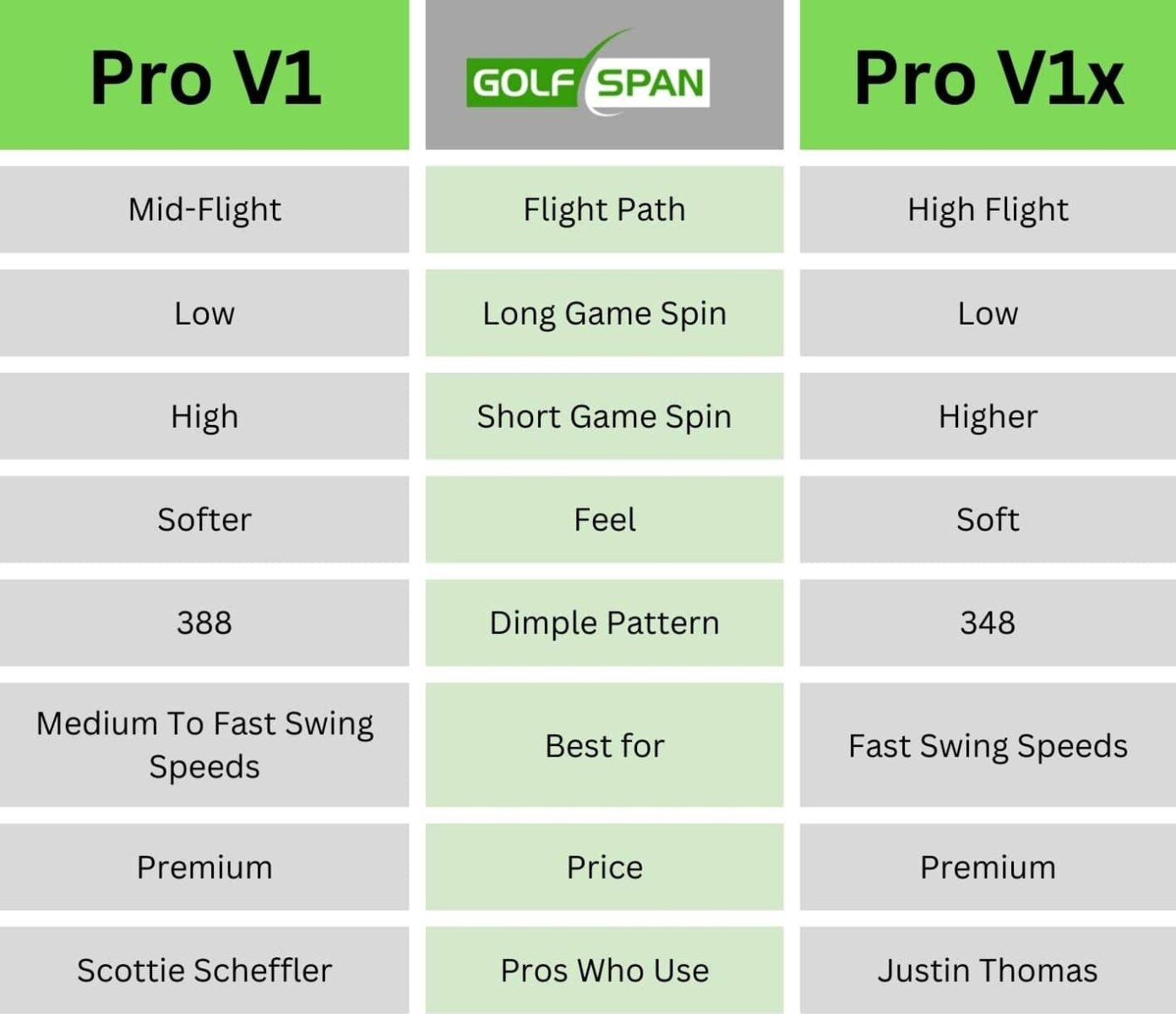
Pro V1: Best for Distance

- Increased distance from the more penetrating flight and roll
- Medium swing speeds will get more consistency
- Increased roll on long shots
- Outstanding greenside spin
- Softer feel
- Lower compression
- Less carry distance compared to the Pro V1x
The Pro V1 in 2024 proved even softer than previous editions , responding well to wedge shots and generating outstanding greenside spin. Its low compression makes it easier to strike and get the ball in the air, compared to the higher-rated Pro V1x.
The mid-flight path, fast ball speed, and added roll prompt the Pro V1 to roll farther and generate more distance .
Fast-swinging low handicappers who like a penetrating ball flight with low long-game spin will get the most out of the Pro V1.
From a mid-handicapper perspective, I enjoyed a medium launch and flight, especially compared to the Pro V1x. However, higher swing speeds tend to launch the Pro V1 lower and generate more roll-on-long shots.
Want to see how the Pro V1 and Pro V1x compression compare with other popular golf balls? Check our golf ball compression chart .
Pro v1x: best for spin.
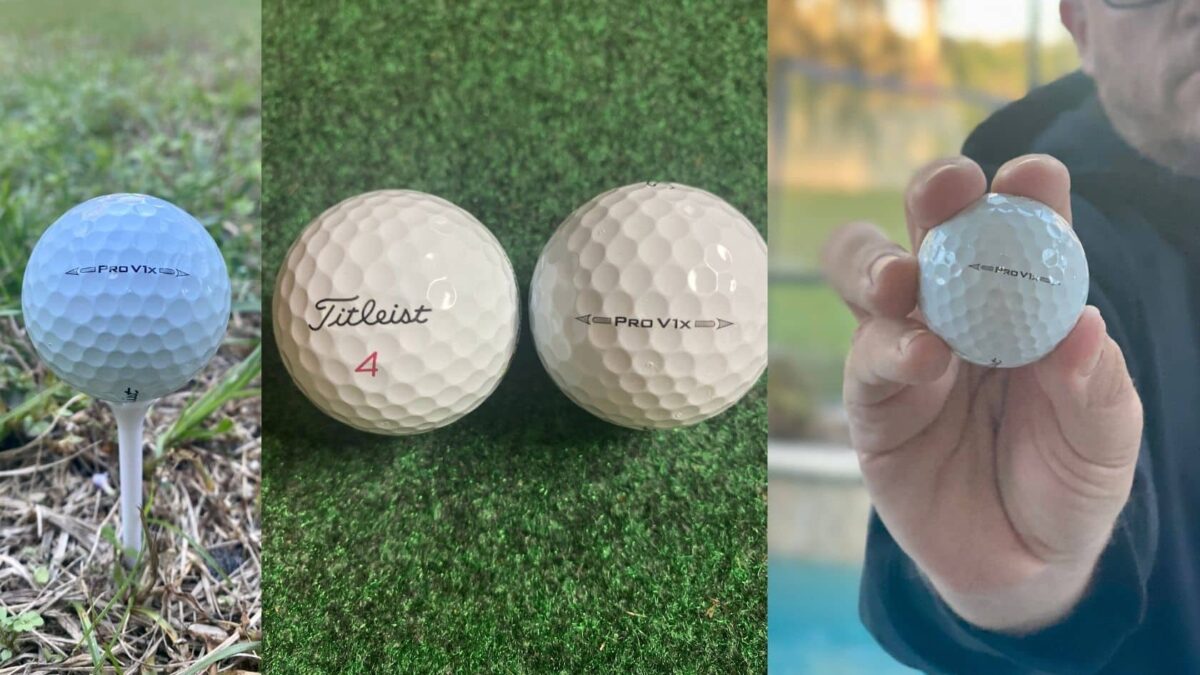
- Increased wedge spin
- Durable construction
- Suits fast swing speeds
- High launch
- Premium price tag
- Not as much roll as the Pro V1
The Pro V1x launched high for my fast swing speed playing partner, boosting his carry distance . However, it produced inconsistent launch, carry, and distance for moderate swing speeds like mine.
The Pro V1x excelled around the green, delivering an average of 10% more spin on wedge shots than the Pro V1.
I love the Pro V1x for its wedge spin. The ball bites hard on flop and full shots, and it hops and stops on pitch shots, allowing me to attack the flag. The new soft cast urethane cover on the 2023 version is softer, and I can get more spin with the Pro V1x than the original.
The Pro V1x proved to be the highest-launching ball among three out of the four golfers in my group. They are all medium to fast swingers who noticed that the Pro V1x launched and peaked at a higher apex than the Pro V1. The elevated ball flight increased my playing partners’ carry distance over the Pro V1.
I was the odd one out and launched the Pro V1 higher than the Pro V1x. I put it down to a higher compression score and firm feel of the latter.
Read More: Titleist Velocity vs. Pro V1 — Tried & Tested For You
Fifty percent of the top 10 ranked golfers use Pro V1 golf balls. This includes Scottie Scheffler, Viktor Hovland and Matt Fitzpatrick, Max Homa and Brian Harman. Patrick Cantlay and Wyndham Clark play the Pro V1x.
Read More: Chrome Soft vs. Pro V1: Differences, Pros, Cons
Frequently asked questions.
The new Pro V1x offers more spin, less noise, and a softer feel than previous iterations. However, it is still firmer than the Pro V1.
The Pro V1 is 9 compression points softer than the Pro V1x, with a score of 87. The Pro V1x is firmer, scoring 96.
The Pro V1 is a firm golf ball with a compression rating of 87. However, the Pro V1x is much firmer at 96. You need a much faster swing speed to effectively use the Pro V1x.
Titleist switched the Pro v1 and Pro V1x back when they released the 2017 versions of the balls. Before this, the Pro V1x was a lower-spinning ball than the Pro V1. However, since that time, the Pro V1x has remained the higher-spinning ball of the two.
High handicappers can use the Pro V1 as it is both consistent and encourages a straight flight path. However, the high compression rating of 96 makes it a poor choice for most high handicappers. We prefer the Pro V1x which has a lower compression rating of 87. It too has low long-game spin.
There is no doubt that the Pro V1x is a better pick for players with slow swing speeds. With a compression rating of 87 compared to the Pro V1's 96, you can afford to have a swing speed that is around 10mph lower.
- What Is the Most Used Golf Ball on the PGA Tour?
- The 10 Most Expensive Golf Balls: Worth the Money?
- The 7 Best Titleist Golf Balls

Matt Callcott-Stevens
Matt has played golf since he was 4 years old and has written over 150 articles at GolfSpan since 2021. Matt specializes in product reviews using his postgraduate degree in Sports Marketing from Johan Cruyff Institute. Matt has a handicap index of 10.8 and currently plays weekly at Pilar Golf Course near his home in Buenos Aires, Argentina. He also loves his Callaway Odyssey Exo Rossie putter and likes a pepper steak pie with curry gravy at the turn. You can connect with him on LinkedIn .
- Best score : 70
- Favorite club : Callaway Odyssey Exo Rossie
- Favorite ball : Srixon Q-Star Tour
- Favorite food at the turn : Pepper steak pie with curry gravy
- Matt Callcott-Stevens https://www.golfspan.com/author/matt-callcott-stevens Achievable Golf Goals To Lower Your Score in 2024
- Matt Callcott-Stevens https://www.golfspan.com/author/matt-callcott-stevens 7 Best Golf Balls For Slow Swing Speeds: Pros, Cons, Reviews
- Matt Callcott-Stevens https://www.golfspan.com/author/matt-callcott-stevens 5 Best Golf Swing Analysis Apps: iPhone, Android, & Free
- Matt Callcott-Stevens https://www.golfspan.com/author/matt-callcott-stevens Provisional Ball in Golf: When To Use & How It Speeds Play
You might also like these

CONNECT WITH US

TaylorMade Tour Response vs Titleist Pro V1
Find out how TaylorMade’s Tour Response ball stacks up against the Titleist Pro V1
- Sign up to Golf Monthly Newsletter Newsletter
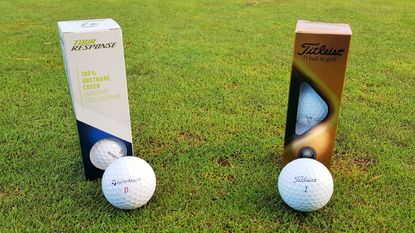
Ball Flight
Which ball should you choose.

The Tour Response offers premium-like performance without the price tag. It is great for those who have a faster-than-average swing speed and want good control around the greens too.
- Great all-round feel
- Good spin around the greens
- More affordable price
- Slightly quicker swing speed needed
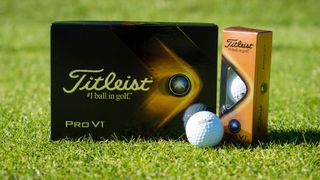
From tee-to-green, it offers superb, but distinct, all round performance. We were seriously impressed with the strength and consistency of the flight, particularly in the wind.
- All-round performance
- Impressive in the long game
- Excellent control
- High levels of consistency
- Soft, responsive feel
- Premium price tag
- Low spin players will need Pro V1x
In this review of the TaylorMade Tour Response golf ball , we compare it to the Titleist Pro V1, an established favourite on Tour and widely regarded as one of the best golf balls on the market today.
TaylorMade surveyed large numbers of amateur golfers to find out what they wanted from a golf ball, especially in terms of performance and budget, and found many playing expensive premium balls that weren’t ideally suited to their skill level or physical ability.
The solution was to create a three-piece ball that could offer tour-level performance, at a lower price point with a lower compression. The softer core, rated as a 70 compression, makes it easier to hit and delivers comparable distance and feel benefits to more golfers across a wider range of skill level.
TaylorMade wanted to tempt golfers to look beyond market leading tour balls and so it launched Tour Response.
We tested it out on the golf course and on a launch monitor to see how it compared to Titleist’s market leading Pro V1.

The TaylorMade Tour Response has a premium look and feel. Its 322 dimples form a clean uniform pattern and it has a quality soft and tacky feel thanks to its 100% urethane cover, a feature usually reserved for only the best premium golf balls .
The number on the Tour Response is a subtle red and its branded alignment arrow shows the ball name as well as offering alignment options for tee-shots and putting.
Get the Golf Monthly Newsletter
Subscribe to the Golf Monthly newsletter to stay up to date with all the latest tour news, equipment news, reviews, head-to-heads and buyer’s guides from our team of experienced experts.
The Titleist Pro V1 has more dimples (388) in a neat pattern with a black number and classic Titleist scripting. The alignment arrow carries the Pro V1 model name.

The TaylorMade Tour Response feels firmer than the Pro V1 on strike, especially off the putter face and wedges. It’s less noticeable in the long game.
While centre strikes and good shots respond well with the Tour Response, mishits felt dull and a little lifeless – at times the ball felt heavy off the face.
The Pro V1 felt superior around the greens, more responsive, generating more spin in short game tests and especially on short to mid-range low flighted pitch shots. On higher softer shots, like lobs and greenside pitches, both balls responded well on landing.
- Read our full TaylorMade Tour Response Ball review
The flight and spin profiles of the TaylorMade Tour Response and the Titleist Pro V1 are quite different and this bore out in testing, especially with the driver and irons.
The Tour Response is a high launch low-spin ball with a softer compression core. The Titleist Pro V1 is designed to launch lower and spin less, flying with a penetrating trajectory.
Both balls stopped quickly on approach shots into greens but the Pro V1 had a noticeably lower flight. Tour Response had a similar flight profile to the best TaylorMade golf balls like the TP5 and TP5 X, launching mid-high with less spin and a straighter flight.
- Read our full Titleist Pro V1 ball review

In driver testing, TaylorMade Tour Response launched high and flew with a stable consistent flight. Launch monitor testing returned spin rates just below 3000, high ball speeds and distances close to those recorded for the Pro V1.
The Titleist Pro V1 was longer on the launch monitor tests, by 7 yards on the best struck driver shots and by up to four yards with 7 iron.
Despite this, the Tour Response is plenty long and averaged over 170 yards with 7-iron on the launch monitor – which compares well to my stock yardage of 169 – achieved during gapping testing on a Foresight GC2 launch monitor.
Given its lower price point, TaylorMade’s Tour Response does deliver the distance it promises, the stability of flight and the control and spin on hitting the green.
Both balls span plenty on a variety of short game shots around the green, the Pro V1 edging it slightly because of its combination of softer feel off the face and consistently high spin reaction.
Launch monitor testing showed that I got more short game spin with the Pro V1 than the TaylorMade Tour Response.
Both balls were consistent in flight and performed well in a cold 20-mph wind during on-course testing with Pro V1 standing out as the more penetrating option. I’d class both as reliable options for golfers seeking to improve accuracy in their long game.
Choose the TaylorMade Tour Response if... - You want a value-for-money three piece golf ball that performs like tour models - You want more high launch, good distance and stable flight in the long game - You prefer a firmer feel green side - Value durability over time
Choose the Pro V1 if… - You spin the ball too much with your driver - Want a more penetrating ball flight - Prefer a softer feeling ball for the short game and putting
Matthew Moore fell in love with golf hitting an old 3-iron around his school playing field imagining rugby posts were flags and long jump pits as bunkers.
He earned golf scholarships to the University of St Andrews and Emory University, Atlanta, U.S.A and dreamed of playing professionally before training as a journalist.
He has worked at Golf Monthly and CNN Sports as well as covering golf news, features, products and travel as a freelance writer and TV presenter for newspapers, magazines and corporate clients. Matthew has interviewed Ryder Cup Captains, Major Champions and legends of the game and rates sharing a glass of rioja and a bowl of nuts with Miguel Angel Jimenez as his favourite moment. Matthew plays off 1, has won five club championships and aced the first hole of Augusta National’s Par-3 course in 2002.

TaylorMade’s Tour Response tested against its sister ball – TaylorMade Soft Response
By Matthew Moore Published 25 November 21
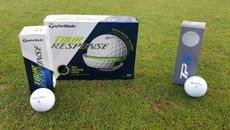
Which ball came out on top in a head-to-head between TaylorMade’s tour performance golf balls?
By Matthew Moore Last updated 8 September 22
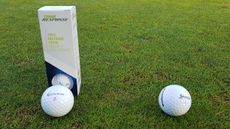
TaylorMade Tour Response and Srixon Q-Star Tour are both affordable alternatives to premium balls but which one came out on top in our review test
By Matthew Moore Last updated 21 July 22

The 2018 champion is relying on a strong performance for the best chance of appearances at the other Majors in 2024
By Mike Hall Published 11 April 24

The popular model has been updated for 2024 - so what we do think of the changes? Here's our verdict...
By Joel Tadman Published 11 April 24
- Contact Future's experts
- Terms and conditions
- Privacy policy
- Accessibility statement
- Cookies policy
- Advertise with us
Golf Monthly is part of Future plc, an international media group and leading digital publisher. Visit our corporate site . © Future Publishing Limited Quay House, The Ambury, Bath BA1 1UA. All rights reserved. England and Wales company registration number 2008885.
Titleist Tour Speed Vs. Pro V1 Golf Balls: In-depth Differences
Step onto any golf course and the name “Titleist” will echo around you. For good reason, too. Titleist has carved a prestigious name in golf, creating some of the industry’s best and most sought-after balls.
Today, we’re going to put two top contenders in their lineup head to head: the Titleist Tour Speed and the Pro V1.
A Brief Comparison Table
Journey into titleist’s territory.
Before we delve into the comparisons, let’s get acquainted with the brand that brings us these exceptional products. Titleist, a significant player in the golf industry, is known for its commitment to quality, performance, and tradition.
Golfers worldwide, from beginners to professionals, swear by Titleist for their consistency and durability.
Now, the stage is set for the two big hitters – the Tour Speed and the Pro V1. They’re both excellent choices, but which one will emerge as the champion? Let’s find out.
Unmasking the Titleist Tour Speed
The Titleist Tour Speed, a recent addition to the lineup, is a testament to the company’s relentless drive for innovation. This golf ball has been specifically designed to provide exceptional distance and control in all parts of the game.
Pros of Tour Speed
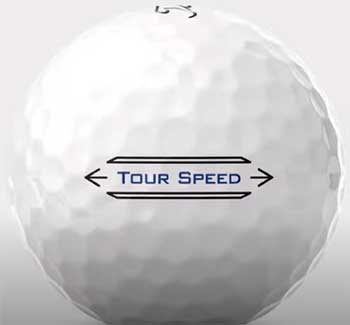
- Speed and Distance: The Tour Speed’s name gives it away. It’s engineered for speed and distance, and it delivers on this promise. The thermoplastic urethane cover, combined with a unique LSX core, generates high speed and low long game spin. This leads to more distance off the tee and in the long game.
- Shot Control: It’s not all about distance, though. The Tour Speed provides impressive control on the greens. It offers more spin and less roll, giving golfers the ability to stop the ball quicker on approach shots.
- Price: Another plus is the cost. The Tour Speed is a more budget-friendly option than the Pro V1, making it a great choice for golfers who want high performance without breaking the bank.
Cons of Tour Speed
- Feel: Some golfers have reported that the Tour Speed has a firmer feel than they prefer. This comes down to personal preference, though, and may not be a drawback for everyone.
Probing the Pro V1
The Pro V1 is a legendary name in the world of golf. It’s the gold standard, trusted by professionals and amateurs alike.
Pros of Pro V1
- Soft Feel: The Pro V1 shines in its incredibly soft feel. The softer urethane elastomer cover provides excellent feedback on every shot and is a joy to play around the greens.
- Consistent Flight: Consistency is key in golf, and the Pro V1 delivers. It offers a very stable, penetrating ball flight, and its drop-and-stop short game control is second to none.
- Durability: Pro V1 balls are robust and durable. They withstand rough shots better and typically last longer than the average golf ball, making them a worthy investment.
Cons of Pro V1
- Price: The primary downside of the Pro V1 is its cost. It’s one of the most expensive balls on the market. Although it offers excellent performance, the price tag may deter some golfers.
Key Differences between Titleist Tour Speed and Pro V1
Avid golfers are always in pursuit of a ball that fits their game style perfectly. The search is, quite literally, for a game-changing ball. That’s why knowing the key differences between two high performers like the Titleist Tour Speed and Pro V1 can make all the difference.
Let’s delve deeper and see how these balls differ in their construction, performance, and suitability for different golfers.
- Constructing Excellence: Tour Speed vs. Pro V1

Construction-wise, the Tour Speed and Pro V1 are different in their core and cover makeup.
The Tour Speed is a three-piece golf ball that includes a high-speed core, a fast ionomer casing layer, and a thermoplastic urethane cover.
This construction is designed to give high speed and low long game spin, enhancing the distance achieved.
On the other hand, the Pro V1 is a three-piece multi-component golf ball with a very soft compression ZG process core, ionomeric casing layer, and softer urethane elastomer cover.
This design focuses on providing an incredibly soft feel, long-lasting durability, and excellent short game spin.
- Performance Parameters: Distance, Spin, and Feel
When it comes to distance, the Tour Speed shines. Thanks to its LSX core and thermoplastic urethane cover, this ball is designed for maximum speed. If you’re looking for a ball that will give you extra yards off the tee, the Tour Speed may be your best bet.
Spin control is where the Pro V1 outclasses most of its competitors. Its soft urethane elastomer cover ensures fantastic short game spin control, providing golfers with a precision edge around the greens. If you value control over your shots, the Pro V1 has got you covered.
The feel is another crucial point of differentiation. The Pro V1 has an incredibly soft feel that many golfers love. It provides excellent feedback, allowing golfers to fine-tune their short game. The Tour Speed, while not unpleasant, has a noticeably firmer feel due to its construction.
- Suitability: Who Should Use Which Ball?
The Pro V1 is ideal for low handicappers and professional golfers who demand superior short game control and soft feel. Its high price point reflects its high-level performance and is often considered a worthy investment for serious players.
On the other hand, the Tour Speed, with its distance-centric design and lower price point, is excellent for mid-to-high handicappers who want to improve their game. It offers impressive distance, reasonable control, and a firmer feel, all at a friendlier price than the Pro V1.
Also Read: Differences Between Titleist Tour Speed And AVX Golf Balls .
Wrapping It Up
So, which is the better ball?
The Titleist Tour Speed or the Pro V1? Well, it all comes down to your individual needs as a golfer. The Tour Speed offers impressive speed, distance, and a more friendly price point.
However, if you’re seeking an incredibly soft feel, consistent flight, and don’t mind investing a little extra, the Pro V1 could be the perfect fit for you.
Remember, the best way to decide is to try both out for yourself. After all, the right golf ball can turn a good game into a great one.
Happy golfing!
Related Posts
Goon tape vs. hockey tape: in-depth differences with features.
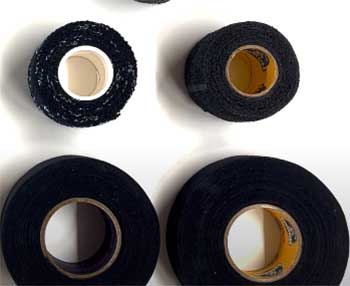
Hockey enthusiasts around the globe are well familiar with the quintessential argument that stirs up quite a buzz: the classic Goon Tape and Hockey Tape…
StrackaLine Vs. PuttView: An In-depth Comparison and Review

In the world of golf, StrackaLine and PuttView have emerged as two of the top tools for players seeking to elevate their games. Whether you’re…
Leave a Comment Cancel Reply
Your email address will not be published. Required fields are marked *
Save my name, email, and website in this browser for the next time I comment.
This site uses Akismet to reduce spam. Learn how your comment data is processed .

IMAGES
VIDEO
COMMENTS
Compression: 108.4. Cover Material: Urethane. How Many Pieces: 4-Piece. Core Material: Dual-Core. Dimple Type: Spherically-tiled tetrahedral (348) Spin Level: Low. Best Suited for: Low handicappers. Titleist Tour Soft Quick Facts. Compression: 65. Cover Material: Ionomer. How Many Pieces: 2-Piece.
Titleist added the soft-center, high-energy dual-core to the ball to increase the ball speed with lower spin. Ball speed is increased due to its ionomeric casing layer, for more yardage. Overall the Pro V1 is forgiving and produces low spin on impact and has the soft feel to allow you to work around the greens.
Final Words: Tour Soft or Pro V1? If you're looking for an affordable alternative with all of Titleist's legendary performance characteristics, look no further than the Tour Soft! The Tour Soft is a great ball that gives you the same performance as the Pro V1 at a much lower price.
Both the Titleist Tour Soft and Pro V1 are used by professional golfers on the PGA Tour. However, the Pro V1 is the more popular ball among professionals. It has a higher compression, which allows for more control and a better feel around the greens.
The ball's penetrating ball flight, similar to Titleist's Pro V1x, adds a new way to play when entering the green with an iron shot. A golf ball like the NXT Tour, the Tour Soft offers a powerful core, soft cover, and a forgiving nature that keeps the shot along the target line.
The ProV1X has less dimples but they are bigger and deeper and along with the extra inner layer, creates more spin. The AVX has less dimples than the ProV1 but the dimples are very shallow. Take a close look. Those shallow dimples are creating less resistance, thus the lowest spinning of the premier balls.
Pro V1 and Pro V1x, as well as AVX, leverage cast-urethane cover technology. We can save the cast-versus-TPU cover conversation for another day but, within the Titleist ecosystem, TPU (which is has co-opted as Titleist Performance Urethane ) is good but cast urethane is better.
on February 25, 2021. 50 Words or Less. The 2021 version of the Titleist Pro V1 and Pro V1x maintain the same outstanding performance of previous generations. Pro V1 feels slightly softer. Slightly higher short game spin in both models. Check out our review of the 2023 Pro V1 and Pro V1x HERE. Introduction.
The 2023 Titleist Pro V1 feels a little softer, launches a little lower and spins a little less than the 2023 Titleist Pro V1x. The ball that has dominated professional tours for more than 20 years continues to serve everyday golfers as well.
It's unlikely you'll notice the few dimples on Pro V1x, but there are 40 fewer should you wish to count them. Feel. The Pro V1 ball does feel fractionally softer than the Pro V1x, which is especially noticeable around the green. The Pro V1x has a slightly more clicky sound, which many good players prefer, especially on and around the greens.
The Titleist Tour Soft ball comes with a thin cover and is soft enough to effectively produce a long ball with exceptional grip. But that doesn't mean the softness can take away the control which comes from Pro V1. Which golf ball is suitable for your game: Titleist Tour Soft vs Pro V1?
By Rick V., Team Titleist Staff On January 22, 2021 Balls. By introducing a reformulated, softer urethane cover for the new Pro V1 and Pro V1x, Titleist R&D solved for a two-part challenge. First, the softer cover material generates more spin, resulting in greater greenside control on finesse shots and short approaches to the green.
How the Titleist Tour Speed (left) compares visually to the Pro V1x. Titleist Tour Speed Balls. Visually, on close inspection, the Tour Speed does have a slightly duller, more off-white finish compared to the Pro V1s along with a larger, more bolded logo but any differences in dimple pattern are impossible to spot.
New Pro V1x gives players who prefer high flight and spin the performance needed to attack every green - now with more speed than ever. Pro V1x elevates players' games with high, longer ball flight on long game shots and outstanding greenside spin and control.
So, PGA Tour players can work the Pro V1x with more authority because it produces reliable distance and consistent spin, even if it comes with higher ball flight on longer shots. For amateurs, the Pro V1 is the right golf ball for their skill set because it delivers more length with a softer feel around the greens.
Choosing Between Pro V1 and Pro V1x: Pro V1 is the best ball for players seeking very low long game spin, more distance, penetrating and consistent flight, and Drop-and-Stop greenside control, all of which complements Pro V1's very soft feel.
Pros. Increased distance from the more penetrating flight and roll. Medium swing speeds will get more consistency. Increased roll on long shots. Outstanding greenside spin. Softer feel.
Construction and Core: Titleist Pro V1: The Pro V1 features a three-piece construction. It has a softer core than the Pro V1x, which provides a lower spin off the driver for more distance. The softer core also enhances feel and control on approach shots and around the greens.
More affordable price. Against. Slightly quicker swing speed needed. 2021 Titleist Pro V1 Ball. Visit Site. From tee-to-green, it offers superb, but distinct, all round performance. We were seriously impressed with the strength and consistency of the flight, particularly in the wind.
Explore the full lineup of Titleist Pro V1 and Pro V1x golf balls and find the right model for your game on Titleist.com. Enable Accessibility > Balls; ... Team Titleist; Tour; Instruction; Fitting; POPULAR SEARCHES ... Soft (3) Firm (5) Price $50-$59 (3) $60-$69 (2) $70-$79 (3) Customizable.
Maxfli Tour X: One significant advantage of the Maxfli Tour X is its more affordable price point compared to the Titleist Pro V1x. It provides excellent performance for golfers looking for a premium ball without breaking the bank. Titleist Pro V1x: The Titleist Pro V1x is considered a high-end golf ball, and it comes with a premium price tag.
The Titleist Pro V1x and the Callaway Chrome Soft X are both four-piece golf balls, which means they have four layers of materials that work together to provide optimal performance. However, the design of these layers is different between the two balls. The Pro V1x features a dual-core design, with a larger inner core and a smaller outer core.
Constructing Excellence: Tour Speed vs. Pro V1; Titleist Pro V1 Golf Ball. Construction-wise, the Tour Speed and Pro V1 are different in their core and cover makeup. The Tour Speed is a three-piece golf ball that includes a high-speed core, a fast ionomer casing layer, and a thermoplastic urethane cover.
Not sure what a plain Titleist ball is. Velocity, Tour Soft, and TruFeel are all labeled and not just plain. Go to Balls tab here. Read about each ball. There is an option under Fittings for a virtual ball fitting. The expert will ask you about your game, suggest a primary and secondary ball to trial and might even send you a 2 pack of each.
New Pro V1 and Pro V1x feature lower long game spin for more distance and excellent greenside spin for unmatched scoring performance. Balls; Clubs; Gear; Team Titleist; Tour; ... Team Titleist; Tour; Instruction; Search. Search. Popular Searches. Titleist Drivers; Golf Balls; Golf Bags; Products. Pro V1. $50. Pro V1 x. $50. T200 Iron. $200 ...
TP5X Or Pro V1X. While I know this is a forum full of Titleist fans, but I'm going to ask anyways, I have been playing a TP5x ball for about 6 months now and love them, however I am switching a lot of my clubs over from TM to Titleist and wondering if I should switch to Pro Vs, Does anyone actually know the differences and if so whats your ...